
Original Link: https://www.anandtech.com/show/1660
Value RAM Roundup: Computing On a Budget
by Wesley Fink on April 11, 2005 4:26 PM EST- Posted in
- Memory
If money were no object in buying a new computer system, enthusiasts would almost always choose the fastest memory with the best timings and the largest overclocking potential. The reality for most, however, is that a new system purchase or upgrade is most often a question of where to put your money for the greatest performance return. To make those kinds of decisions on a system purchase, you really need to know the real difference in performance between buying the best and buying something half the price, and possibly putting the money saved elsewhere for a larger performance gain.
These questions of the real impact of memory speed and timings on performance are things that we have talked about in many memory reviews. AnandTech has always been an advocate of real world performance measurements, and we've shunned using just synthetic benchmarks in our testing of every type of component. This is not because synthetic benchmarks are not useful - they are often very revealing of component differences. It is because running just synthetic benchmarks can severely distort the picture of performance with real applications and real games. That is why we always use games and the pure number-crunching Super Pi in our memory tests. It is also the reason why we test using both Buffered (Standard) and Unbuffered synthetic benchmarks. We have found in much of our testing that the less commonly used Unbuffered benchmarks more closely mirror how games really respond to memory differences.
This quest for real performance differences is also the reason why we moved to testing different memory speeds at the same CPU clock speed in our Athlon 64 memory tests. The AMD CPU, with unlocked multipliers, allowed us to finally remove the CPU speed differences from our memory tests so that you could finally see the true impact of memory speed increases and memory timings on performance. As you have seen in past reviews, those performance differences are very real, although they are much smaller than many memory manufacturers might want you to believe. On the other hand, faster memory speeds and faster memory timings do improve performance, no matter what some nay-sayers are determined to prove.
Let's state, right up front, that if you're on a tight budget, memory is often a good place to save a little money by buying less than the best and moving that cash to a better CPU or a better video card. You are likely to get a bigger performance boost with the extra $150 that you save on memory by buying a faster CPU or an upgraded video card. But don't be misled. The upgrade to the next higher CPU would normally increase performance maybe 5 to 10% - about the same as the difference in performance between cheap, slow memory and fast memory with tight timings. Video cards usually yield more than a 10% boost for that same $150.
If you do need to balance and buy less than the best in memory, the need for help is even greater than if you can afford whatever you want. Some Value RAM is pretty basic and slow, and some is just about as good as the best and most expensive that you can buy. For that reason, it was well beyond time for our first Value RAM roundup. There are some disappointments and a few very pleasant surprises. We think that you will be surprised by how much performance there is in some cases, and how little in others, when you're shopping for Value RAM.
The Memories
The first task in our look at Value RAM was to define Value RAM. With top memories selling for $250 to $400 (or even higher) for a 1GB kit, we decided that a price limit of $200 for a 1GB kit (2x512MB DIMMs) of DDR memory would be our cut-off. Admittedly, this excludes some good value Samsung TCCD kits from companies like PQI and Patriot, but these products are really just good buys and marketed by the companies as Performance memory.We requested Value RAM for our review from Corsair, Kingston, Mushkin, OCZ and Transcend as a representative cross-section of the memory industry. We asked these manufacturers to supply a 1GB kit (2x512MB) of a Value RAM product or products that sold on the web for less than $200. We asked them to supply whatever RAM they wished that met these criteria, which we would be comparing in performance to other Value RAM products in a memory roundup.
All the manufacturers supplied one or more samples for testing except Corsair. Corsair emailed us, stating that "Our policy is not to send Value Select parts for review for a variety of reasons. After a quick discussion here we decided to stick with that policy and sit this one out." When we asked for clarification, Corsair expressed concern that we would be testing performance and overclocking of their Value products when memory chips change frequently on these products. The concern is that the overclocking performance we would report in a roundup today might not be what a customer would get tomorrow because chips change frequently in value products. Corsair recommended that customers looking for overclocking and enthusiast level performance should purchase Corsair products that are geared to performance and overclocking, where results are consistent.
The Value RAM roundup resulted with seven memory pairs from four manufacturers.
| Manufacturer | Description (Memory Chips) |
Memory Speed | Rated Timings | Web Price (1GB) |
| Kingston | KVR400X64C25/512 (Kingston) |
400 DDR | 2.5-3-3 | $142 |
| Kingston | KVR400X64C3AK2/1G (Elpida) |
400 DDR | 3-3-3 | $100 ($91 on sale) |
| Mushkin | EM Series PC3200 (Unknown) |
400 DDR | 3-3-3 | $147 |
| OCZ | PC3200 Premier P/N OCZ4001024PDC-K (PSC) |
400 DDR | 2.5-3-3-7 | $121 |
| OCZ | PC3200 Value Series P/N OCZ4001024WV3DC-K (Winbond - Value VX) |
400 DDR | 2.5-3-3-7 | $115 |
| OCZ | PC3200 Gold P/N OCZ4001024ELDCGE-K (Winbond BH5) |
400 DDR | 2-2-2-5 | $195 |
| Transcend | JM366D643A-50 (JetRam) |
400 DDR | 2.5-3-3 | $100 |
The seven memories represent quite a range of choices in memory under $200 for a Gigabyte. First, we were pleasantly surprised that all of the memories except one now actually cost below $150 for a Gigabyte. That one memory, OCZ PC3200 Gold, will still interest many Value RAM buyers because it represents the revival of Winbond BH5 chips, which were discontinued from the market over 6 months ago. We are told that Winbond is manufacturing BH5 again from old dies, and we will be testing this Value RAM at the higher voltages possible on the DFI nForce4 motherboard.
The other big surprise is also from OCZ. We learned (when OCZ introduced their VX memory at DDR500 2-2-2 speed) that there would also be a Value Series version of the VX. What we did not expect was that the new "Value VX" would cost just $115 for a Gigabyte of memory. These are the same chips that were top-performers in a recent memory review. The Value Series uses unbinned chips, so performance is not guaranteed, but we were still anxious to see if this or the new Value BH5 might be the proverbial "silk purse from a sow's ear" for the cheap computer enthusiast. We all like to get something for nothing - or, at least, for very little money.
As you will see from the results, there were quite a few surprises in Value RAM performance. This includes a few very cheap but solid performers that will satisfy many users, and a couple of memories that are as mundane as we expect of Value RAM. For those of you looking for dynamite performance at cheap prices, we also found that silk purse amongst the Value RAM candidates.
Performance Test Configuration
All seven Value RAM memories were tested on the DFI LANParty nF4 SLI-DR used in our most recent memory reviews. nForce4 is PCI Express, so we used the PCIe version of our standard nVidia 6800 Ultra for testing. Other components remain the same as used in the memory setup in Athlon 64 Memory: Rewriting the Rules. Performance was compared to the 5 top performing memories tested on this same platform in OCZ VX Revisited: DDR Updates on DFI nForce4 and Patriot DDR400 2-2-2/DDR533 3-4-4: Performance AND Value.The A64 test bed includes components that have been proven in Socket 939 Athlon 64 benchmarking, such as the Socket 939 4000+ (same specifications as FX53), and the OCZ Power Stream 520 Power Supply. Since the Athlon 64 tests represent a new series of DDR testing, we are using the current generation nVidia 6800 Ultra video card for benchmarking. We have found the 6800 Ultra to be a particularly good performance match to nVidia motherboards.
All other basic test conditions attempted to mirror those used in our earlier Intel memory reviews. However, test results are not directly comparable to tests performed on the Intel test bed.
| AMD nForce4 Performance Test Configuration | |
| Processor(s): | AMD 4000+ (FX53) Athlon 64 (2.4GHz, Socket 939, 1 MB cache, Dual Channel, 1000HT) |
| RAM: | Kingston KVR400X64C25/512 (DS) 2X512MB Kingston KVR400X64C3AK2/1G (DS) 2X512MB Mushkin PC3200 EM (DS) 2X512MB OCZ PC3200 Value Series (VX) (DS) 2X512MB OCZ PC3200 Gold (BH5) (DS) 2X512MB OCZ PC3200 Premier (DS) 2X512MB Transcend JM366D643A-50 (DS) 2X512MB Patriot PC3200+XLBT (DS) 2X512MB OCZ EL PC4000 VX Gold (DS) 2X512MB Corsair TwinX1024-4400C25 (DS) 2X512MB Crucial Ballistix (DS) 2X512MB OCZ PC3200 Platinum Rev 2 (DS) 2X512MB |
| Hard Drives: | Seagate 120GB SATA 7200RPM 8MB Cache |
| PCI/AGP Speed: | Fixed at 33/66 |
| Bus Master Drivers: | nVidia nForce Platform Driver 6.39 |
| Video Card(s): | nVidia 6800 Ultra 256MB PCIe, 256MB aperture, 1024x768x32 |
| Video Drivers: | nVidia Forceware 71.84 Release |
| Power Supply: | OCZ Power Stream 520W |
| Operating System(s): | Windows XP Professional SP1 |
| Motherboard: | DFI LANParty nF4 SLI-DR |
| BIOS: | 3/10/2005 Release |
In past benchmarking, we have found performance of the nForce4 and nForce3 chipsets to be virtually identical, and we have found AGP and PCIe performance to be virtually the same in the benchmarks that we use for memory testing. Therefore, you can also compare these results to TCCD benchmarks in recent memory reviews. The differences in results are that the nVidia 71.84 driver is a bit faster than the 61.77 used in earlier memory review. The DFI nForce4 platform is also a bit better at memory overclocking than the MSI K8N Neo2 used in past memory testing. The performance differences, however, are not large enough to negate performance comparisons.
With nForce3 motherboards, we achieved the fastest performance on AMD Athlon 64 chipsets (nForce3, VIA K8T800 PRO) at Cycle Time or tRAS of 10. However, the nForce4 appears to behave a bit differently with memory. Therefore, we ran a complete set of Memtest86 benchmarks with only tRAS varied to determine the best tRAS setting for these memories. We achieved the best bandwidth at tRAS settings ranging from 5 to 8, so a tRAS setting of 6 was used for testing wherever possible.
Test Settings
All AMD Athlon 64 processors are unlocked downward, and the FX CPUs are unlocked up and down. This feature allows a different approach to memory testing, which truly measures performance differences in memory speed alone. All tests were run with CPU speed as close to the specified 2.4GHz of the 4000+/FX53 as possible, with CPU speed/Memory Speed increased at lower multipliers to achieve 2.4Ghz. This approach allows the true measurement of the impact of higher memory speed and timings on performance, since CPU speed is fixed, removing CPU speed as a factor in memory performance.The following settings were tested with the seven Value RAM memories on the DFI nF4 test bed:
- 2.4GHz-12x200/DDR400 - the highest stock memory speed supported on VIA 939/nF3-4/SiS755-FX motherboards.
- 2.4GHz-11x218/DDR436 - a ratio near the standard DDR433 speed
- 2.4GHz-10x240/DDR480 - a ratio near the standard rating of DDR466. Several of the Value Memories achieved stable performance at this speed and complete benchmarks were run at this speed with those memories.
- Highest Memory Performance - the highest memory bandwidth and game performance that we could achieve with the memory being tested. This is rarely the highest memory speed that we could achieve. It is normally a lower speed with 1T Command Rate and tighter memory timings.
We ran our standard suite of memory performance benchmarks - Quake 3, Return to Castle Wolfenstein-Enemy Territory-Radar, Super Pi 2M, and Sandra 2004 Standard and UnBuffered. We also included Everest Home Edition memory tests, free at www.lavalys.com, for read speed, write speed, and Latency.
Kingston KVR400X64C25/512
Kingston is the world's largest independent Memory manufacturer with annual sales over $2.4 Billion. Kingston is a very well-known memory brand, and it can be found at almost any large computer dealer. Kingston has a very complete line of memory products from the cheapest Value RAM to their enthusiast HyperX products. Kingston is also a brand that you will often see on sale at the big computer chains.
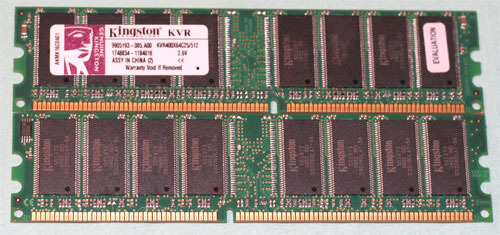
Specifications
The KVR400X64C25/512 is rated at CAS 2.5. Kingston supplied two Value RAM samples for testing - this CAS 2.5 and a lower cost Value RAM rated at CAS 3.| Kingston KVR400X64C25/512 (DDR400) Memory Specifications | |
| Number of DIMMs & Banks | 2 DS |
| DIMM Size Total Memory |
512 MB 1GB |
| Rated Timings | 2.5-3-3 at DDR400 |
| SPD (Auto) Timings | 2.5-3-3-8 |
| Rated Voltage | 2.6V |
Test Results
| Kingston KVR400X64C25/512 (DDR400) - 2 x 512Mb Double-Bank | |||||||
| CPU Ratio at 2.4GHz | Memory Speed |
Memory Timings & Voltage |
Quake3 fps |
Sandra UNBuffered | Sandra Standard Buffered |
Super PI 2M places (time in sec) |
Wolfenstein - Radar - Enemy Territory fps |
| 12x200 | 400 DDR | 2.5-3-2-6 2.6V 1T |
533.0 | INT 2470 FLT 2642 |
INT 6016 FLT 5987 |
83 | 112.0 |
| 12x204 (2.45GHz) |
Highest CPU/Mem Performance | 2.5-3-3-6 2.7V 1T |
533.2 | INT 2636 FLT 2797 |
INT 6143 FLT 6112 |
81 | 112.4 |
We haven't made a mistake here. As you can see, there is really no overclocking headroom at all with this Kingston 2.5 memory. While it actually outperforms specs with 2.5-3-2-6- timings at DDR400 at stock 2.6V, we could not complete our memory benchmarks above a 204 CPU setting. Super Pi and Unbuffered Memory tests worked fine to almost DDR480, but at any setting above 204 (DDR408), games would freeze or run in spurts and freezes. This points to a likely conflict with the AMD on-chip memory controller or the DFI nF4 motherboard, and in fact, the Kingston 2.5 may reach much high memory speeds on an Intel platform.
We have found Aida 32 to be very useful in examining read/write performance and memory latency. Aida 32 is now available as Everest Home Edition, a free download from www.lavalys.com.
| Kingston KVR400X64C25/512 (DDR400) 2x512Mb Double-Bank Everest 1.51 |
|||||
| CPU Ratio at 2.4GHz | Memory Speed | Memory Timings & Voltage |
Everest READ MB/s |
Everest WRITE MB/s |
Everest Latency ns |
| 12x200 | 400 DDR | 2.5-3-2-6 2.6V 1T |
5800 | 1918 | 47.3 |
| 12x204 (2.45GHz) |
Highest CPU/Mem Performance | 2.5-3-3-6 2.6V 1T |
5855 | 1991 | 46.9 |
The Memory Speed range was so limited with the Kingston CAS 2.5 that there is really little on which to comment. However, despite the problems above 204 on the Athlon 64, at stock DDR400, the Kingston KVR400X64C25/512 performed without any problems.
Kingston KVR400X64C3AK2/1G
Kingston's second Value RAM was the most reasonable RAM in our roundup. We found KVR400X64C3AK2/1G available at several Internet dealers for around $100. While we were testing for this roundup, we also saw this Kingston CAS3 Value RAM on sale at one web retailer for $91 for a Gigabyte of memory. This is a high volume, readily available Kingston product that also performs much better than you might expect from the price and specifications.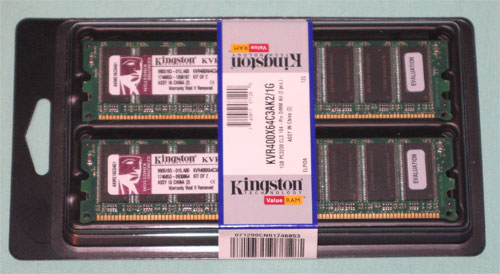

Specifications
The KVR400X64C3AK2/1G is rated by Kingston at CAS 3 and we found the automatic SPD timings to be 3-3-3-8 at stock voltage. These are not particularly exciting timings - even for a Value RAM.| Kingston KVR400X64C3AK2/1G (DDR400) Memory Specifications | |
| Number of DIMMs & Banks | 2 DS |
| DIMM Size Total Memory |
512 MB 1GB |
| Rated Timings | 3-3-3 at DDR400 |
| SPD (Auto) Timings | 3-3-3-8 |
| Rated Voltage | 2.6V |
As you will see in our timings below, however, it is definitely worth your effort to set timings manually for this low-priced Kingston Value RAM, as it is capable of decent performance and overclocking, especially considering its value price.
Test Results
| Kingston KVR400X64C3AK2/1G (DDR400) - 2 x 512Mb Double-Bank | |||||||
| CPU Ratio at 2.4GHz | Memory Speed |
Memory Timings & Voltage |
Quake3 fps |
Sandra UNBuffered | Sandra Standard Buffered |
Super PI 2M places (time in sec) |
Wolfenstein - Radar - Enemy Territory fps |
| 12x200 | 400 DDR | 2.5-3-3-6 2.6V 1T |
530.2 | INT 2586 FLT 2748 |
INT 6057 FLT 6023 |
83 | 111.7 |
| 11x218 | 436 DDR | 3-3-3-6 2.7V 1T |
531.6 | INT 2706 FLT 3927 |
INT 6425 FLT 6354 |
82 | 112.0 |
| 12x225 (2.83GHz) |
Highest CPU/Mem Performance | 3-3-3-7 2.9V 1T |
580.8 | INT 2831 FLT 3023 |
INT 6772 FLT 6719 |
74 | 124.0 |
The Kingston CAS 3 is significantly cheaper than the CAS 2.5, but it also performed fine at CAS 2.5 at the stock DDR400 at standard voltage. Even more important for some, the KVR400X64C3AK2/1G had excellent head room, as it was able to reach DDR450 at voltages available on many motherboards. At $91 to $100 for a matched pair of 512MB DIMMs, this Kingston kit is an outstanding value.
Aida 32 has been useful in the past in examining read/write performance and memory latency. Aida 32 is now available as Everest Home Edition, a free download from www.lavalys.com.
| Kingston KVR400X64C25/512 (DDR400) 2x512Mb Double-Bank Everest 1.51 |
|||||
| CPU Ratio at 2.4GHz | Memory Speed | Memory Timings & Voltage |
Everest READ MB/s |
Everest WRITE MB/s |
Everest Latency ns |
| 12x200 | 400 DDR | 2.5-3-3-6 2.6V 1T |
5750 | 1872 | 47.2 |
| 11x218 | 436 DDR | 3-3-3-6 2.7V 1T |
6030 | 1974 | 48.7 |
| 12x225 (2.7GHz) |
Highest CPU/Mem Performance | 3-3-3-6 2.9V 1T |
6370 | 2083 | 47.2 |
With the somewhat limited range of DDR400 to DDR450 you will not see the kinds of memory read and write increases that we see in top-end memory. However, DDR450 represents a CPU clock of 225, or 12.5% over the base 200 speed. This is often fast enough on the Athlon 64 to allow you to reach the highest speed that your A64 CPU might reach at stock multiplier. In this case, we were able to take our 4000+ from a stock 2.4GHz to 2.7GHz with the memory keeping up. If you need to go even higher, memory multipliers can be lowered, but there is a memory performance penalty when dropping from 1:1 to a lower base memory speed.
All-in-all, the Kingston KVR400X64C3AK2/1G is a surprisingly good performer for memory that you can buy for about $100 per Gigabyte. The timings are not the fastest, but gaming performance at DDR400 is just 8% faster with the fastest 2-2-2 that we have tested at DDR400 (Quake 3 at 530.2 to 572.8, RTCW at 111.7 to 120.2). The real difference between this Value RAM and the expensive memory is at the top, where OCZ VX at top memory speeds can outperform this Kingston at top speed by 10% to as much as 21% in Gaming frame rates.
Mushkin EM Series PC3200
Mushkin is admired by many computer enthusiasts for the quality of their products and the customer service that they provide. In the past, the only way to buy Mushkin memory was direct at www.mushkin.com. Recently, however, Mushkin has also been available through web retailers like Monarch, NewEgg, TigerDirect, and AxionTech. In Canada, Mushkin is available through NCIX.If you do order direct from Mushkin, you will get their famous "pillow pack" that cradles their memory in an air bubble. The point is that Mushkin makes solid products, stands behind their products, and treats customers well.
Mushkin EM is their Value line product, and like other Mushkin memory, it comes in a sealed anti-static bag instead of the fancier packaging that many others use. All Mushkin memory, even this Value product, comes with heatspreaders.
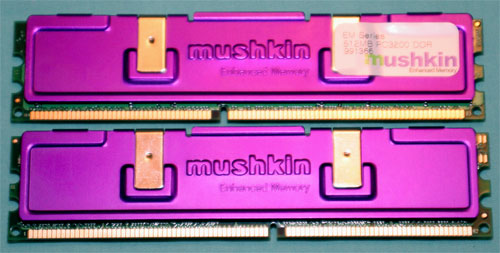
Specifications
The Mushkin EM is specified at the unimpressive specs of 3-3-3-8, but keep in mind that Value RAM is normally about price and not performance.| Mushkin EM Series PC3200 (DDR400) Memory Specifications | |
| Number of DIMMs & Banks | 2 DS |
| DIMM Size Total Memory |
512 MB 1GB |
| Rated Timings | 3-3-3-8 at DDR400 |
| SPD (Auto) Timings | 3-3-3-8 |
| Rated Voltage | 2.6V |
The EM memory performed fine at stock DDR400, but it is another Value RAM with no overhead.
Test Results
| Mushkin EM Series PC3200 (DDR400) - 2 x 512Mb Double-Bank | |||||||
| CPU Ratio at 2.4GHz | Memory Speed |
Memory Timings & Voltage |
Quake3 fps |
Sandra UNBuffered | Sandra Standard Buffered |
Super PI 2M places (time in sec) |
Wolfenstein - Radar - Enemy Territory fps |
| 12x200 | 400 DDR | 3-3-3-6 2.6V 1T |
524.0 | INT 2600 FLT 2752 |
INT 6049 FLT 6005 |
83 | 111.1 |
| 12x205 (2.46GHz) |
Highest CPU/Mem Performance | 3-3-3-6 2.9V 1T |
525.9 | INT 2616 FLT 2749 |
INT 6153 FLT 6130 |
81 | 112.4 |
All the memory manufacturers generally have access to the same memory chips, and we can only surmise that Mushkin chose the chips in our EM sample for price. The manufacturer chose which Value RAM to send us for testing, and we can only wonder why Mushkin chose to send us EM for this roundup. We have tested other Mushkin Value RAM over the years, and we have generally been pleased with the performance and head room of Mushkin value products. Our advice would be to choose this Mushkin EM if you will only run at stock speeds. It could be that the memory is just a bad match to the AMD memory controller or the DFI, but further testing would be required to see if the EM performs better on other platforms.
Aida 32 is now available as Everest Home Edition, a free download from www.lavalys.com. We have found this benchmark to be very useful in examining read/write performance and memory latency.
| Mushkin EM Series PC3200 (DDR400) 2x512Mb Double-Bank Everest 1.51 |
|||||
| CPU Ratio at 2.4GHz | Memory Speed | Memory Timings & Voltage |
Everest READ MB/s |
Everest WRITE MB/s |
Everest Latency ns |
| 12x200 | 400 DDR | 3-3-3-6 2.6V 1T |
5710 | 1873 | 52.8 |
| 12x205 (2.46GHz) |
Highest CPU/Mem Performance | 3-3-3-6 2.9V 1T |
5790 | 1940 | 51.0 |
There's little to analyze with such a small performance range. We would suggest that you choose another Mushkin value RAM if you want to shop for a Mushkin product at low cost. The Mushkin website shows a 1GB CL2 DDR400 kit at $155 compared to $147 for the EM.
OCZ PC3200 Premier
In the past two years, OCZ has moved from relative obscurity to becoming one of the most widely recognized names in enthusiast products. Today, OCZ markets power supplies, heat sinks, memory voltage boosters, and thermal compounds, but OCZ is still best known for their enthusiast memory. Recently, OCZ has also been quite innovative in new product introductions, including products like our current RAM Speed champ, OCZ VX, which requires a very non-standard 3.5 to 3.6V to really shine.What many forget is that like Corsair, Kingston, Mushkin, and other full-line memory companies, OCZ has a very large line of value products. The Premier Series is a Value line, and the PC3200 Premier is a typical Value product, with a web selling price as low as $121 at mWave.
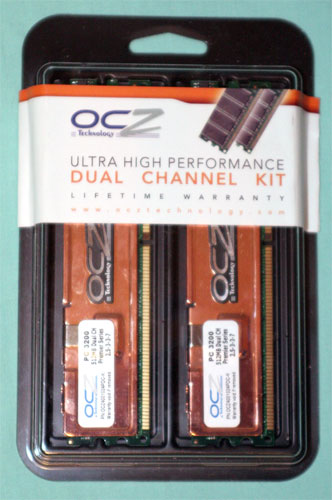
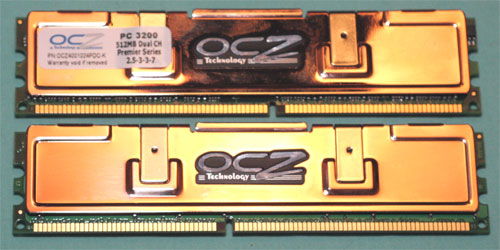
Specifications
OCZ rates their PC3200 Premier at the more aggressive CAS 2.5 timings at DDR400 and stock voltage.| OCZ PC3200 Premier (DDR400) Memory Specifications | |
| Number of DIMMs & Banks | 2 DS |
| DIMM Size Total Memory |
512 MB 1GB |
| Rated Timings | 2.5-3-3-7 at DDR400 |
| SPD (Auto) Timings | 2.5-3-3-7 |
| Rated Voltage | 2.6V |
Test Results
The OCZ PC3200 Premier is the first Value RAM we have tested that reaches DDR480, our next test point on the 2.4GHz ratios. Our samples actually booted as high as DDR500, but memtest86, Super Pi and games were not stable beyond DDR480, regardless of voltage.| OCZ PC3200 Premier (DDR400) - 2 x 512Mb Double-Bank | |||||||
| CPU Ratio at 2.4GHz | Memory Speed |
Memory Timings & Voltage |
Quake3 fps |
Sandra UNBuffered | Sandra Standard Buffered |
Super PI 2M places (time in sec) |
Wolfenstein - Radar - Enemy Territory fps |
| 12x200 | 400 DDR | 2.5-3-2-6 2.6V 1T |
535.0 | INT 2637 FLT 2826 |
INT 6072 FLT 6025 |
83 | 112.4 |
| 11x218 | 436 DDR | 2.5-3-3-6 2.7V 1T |
538.5 | INT 2803 FLT 2969 |
INT 6481 FLT 6410 |
82 | 113.0 |
| 10x240 | 480 DDR | 2.5-3-3-6 2.9V 1T |
546.6 | INT 2901 FLT 3136 |
INT 6708 FLT 6626 |
81 | 114.7 |
| 11x240 (2.64GHz) |
Highest CPU/Mem Performance | 2.5-3-3-6 2.9V 1T |
586.0 | INT 2976 FLT 3214 |
INT 7083 FLT 7007 |
75 | 124.1 |
The Premier actually did a bit better than specified at DDR400 with stable 2.5-3-2-6 timings. It is also worth noting that Premier was stable with CAS 2.5 timings all the way to the memory speed limit of DDR480. This is particularly outstanding performance for a memory that actually sells for $121.
Aida 32 is now available as Everest Home Edition, a free download from www.lavalys.com. Everest has been very useful in measuring read/write performance and memory latency.
| OCZ PC3200 Premier (DDR400) 2x512Mb Double-Bank Everest 1.51 |
|||||
| CPU Ratio at 2.4GHz | Memory Speed | Memory Timings & Voltage |
Everest READ MB/s |
Everest WRITE MB/s |
Everest Latency ns |
| 12x200 | 400 DDR | 2.5-3-2-6 2.6V 1T |
5795 | 1948 | 47.1 |
| 11x218 | 436 DDR | 2.5-3-3-6 2.7V 1T |
6122 | 1998 | 44.6 |
| 10x240 | 480 DDR | 2.5-3-3-6 2.9V 1T |
6661 | 2217 | 44.3 |
| 11x240 (2.64GHz) |
Highest CPU/Mem Performance | 2.5-3-3-6 2.9V 1T |
6668 | 2710 | 40.3 |
With OCZ Premier covering a broader range of memory speeds from 400 to 480, there is more potential to see the true impact of memory speed on performance. With memory timings at a consistent 2.5-3-3 and CPU speed at a constant 2.4GHz, any performance deltas are the result of true performance differences. As we move from 400 to 480 - a 20% speed increase - memory read improves by 15%, write improves by almost 40%, and latency drops by about 17%.
However, these improvements in synthetic memory benchmarks are not reflected by similar improvements in benchmarks with real games. Improving memory speed by 20% - from 400 to 480 - at the same CPU speed improves gaming performance by just 2% to 3%. Clearly, we are getting a better performance increase than this in real-world performance with faster CPU speed. You can see this in the 10% CPU speed increase from 10x240 to 11x240 at the same memory timings. This 10% CPU Speed increase improves gaming FPS by about 8%.
OCZ PC3200 Value Series: "Value VX"
OCZ VX emerged as our memory performance leader in our recent memory review, OCZ VX Revisited: DDR Updates on DFI nForce4. Rated at DDR500 speed at 2-2-2 timings, we quickly learned that you needed a lot of memory voltage to get the most from this memory. In fact, VX really requires 3.5V to 3.6V for best performance. This requires one of the new DFI nForce4 motherboards, an add-on OCZ DDR Booster, or a motherboard memory voltage mod to provide the voltages VX demands.The other part of the VX equation was cost. OCZ bins VX and tests at DDR500 2-2-2 speed, and the cost of that selectivity and guaranteed performance is about $270 for a Gigabyte of RAM. As performance RAM goes, this is a bargain price, but we never considered VX a Value RAM until OCZ dropped a surprise on our doorstep.
With the introduction of DDR500 VX, OCZ announced that they would be also producing a "Value VX" rated at DDR400 and lower voltage. Basically, this Value VX would be an unbinned part not tested for high voltages and high overclocks. That "Value VX" is now on the market as OCZ PC3200 Value Series and selling for about $115 for a pair of 512MB DIMMs!
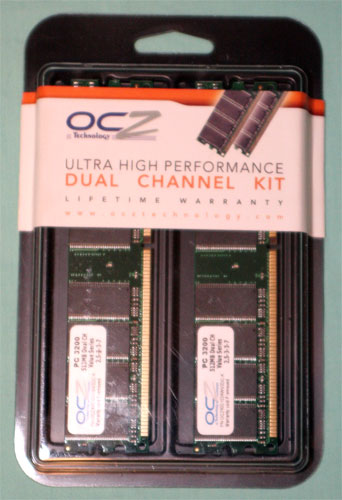
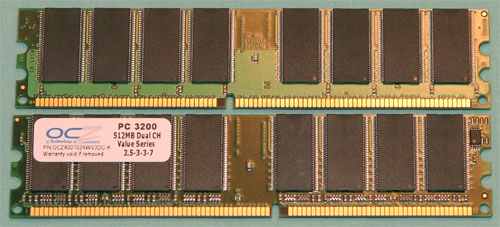
Specifications
OCZ rates Value VX at the very conservative 2.5-3-3-7 at DDR400 at default voltage. The memory does meet these specs, but when you crank up the voltage, these "Value VX" DIMMs turn into a different animal.| OCZ PC3200 Value (DDR400) Memory Specifications | |
| Number of DIMMs & Banks | 2 DS |
| DIMM Size Total Memory |
512 MB 1GB |
| Rated Timings | 2.5-3-3-7 at DDR400 |
| SPD (Auto) Timings | 2.5-3-3-7 |
| Rated Voltage | 2.6V |
There is no mention on the innocent "OCZ PC3200 Value Series" label of what lurks within.
Test Results
| OCZ PC3200 Value (DDR400) - 2 x 512Mb Double-Bank | |||||||
| CPU Ratio at 2.4GHz | Memory Speed |
Memory Timings & Voltage |
Quake3 fps |
Sandra UNBuffered | Sandra Standard Buffered |
Super PI 2M places (time in sec) |
Wolfenstein - Radar - Enemy Territory fps |
| 12x200 | 400 DDR | 2-2-2-6 3.0V 1T |
570.2 | INT 2940 FLT 2929 |
INT 6096 FLT 6148 |
81 | 120.0 |
| 11x218 | 436 DDR | 2-2-2-6 3.1V 1T |
579.6 | INT 3138 FLT3117 |
INT 6478 FLT 6412 |
80 | 120.9 |
| 10x240 | 480 DDR | 2-2-2-6 3.2V 1T |
593.4 | INT 3242 FLT 3352 |
INT 6746 FLT 6789 |
79 | 122.7 |
| 11x245 (2.7GHz) |
Highest CPU/Mem Performance 490 DDR |
2-2-2-6 3.3V 1T |
613.6 | INT 3384 FLT 3459 |
INT 7284 FLT 7204 |
72 | 129.1 |
The binned and tested OCZ PC4000 VX reaches a higher speed of DDR530 at 2-2-2. That just proves the value of binning and testing for performance. But how can we complain about a memory that costs 57% less than 4000 VX and still performs with complete stability at DDR490 at 2-2-2 timings? Frankly, we can't.
You bargain hunters who want to play with VX, 2-2-2 timings, and high memory voltage will want to grab a pair of Value VX. They aren't binned, but we suspect that most will reach DDR480 to DDR500 if you supply the voltage - and some may do even better. That translates into a Clock frequency of 240 to 250, which should be more than enough to supply 1:1 2-2-2 to any AMD A64 at stock multiplier. A 2.4GHz 4000+ would be 2.88 to 3.0GHz at 240 to 250, for example - probably more than what the CPU can do with air cooling. At $115, for a Gigabyte of Value VX, there is now no price barrier to providing 2-2-2 1:1 memory for any AMD CPU - provided you can supply the voltage.
Aida 32 is now available as Everest Home Edition, a free download from www.lavalys.com.
| OCZ PC3200 Value (DDR400) 2x512Mb Double-Bank Everest 1.51 |
|||||
| CPU Ratio at 2.4GHz | Memory Speed | Memory Timings & Voltage |
Everest READ MB/s |
Everest WRITE MB/s |
Everest Latency ns |
| 12x200 | 400 DDR | 2-2-2-6 3.0V 1T |
5877 | 2033 | 45.8 |
| 11x218 | 436 DDR | 2-2-2-6 3.1V 1T |
6170 | 2056 | 44.6 |
| 10x240 | 480 DDR | 2-2-2-6 3.2V 1T |
6666 | 2207 | 44.2 |
| 11x245 (2.7GHz) |
Highest CPU/Mem Performance 490 DDR |
2-2-2-6 3.3V 1T |
8310 | 3321 | 35.2 |
Performance patterns are exactly the same as seen in our recent reviews of VX memory. The unbinned $115 DDR400 memory reached DDR490, while the binned $270 DDR500 version reached DDR530 - with 2-2-2 timings all around. If you want assured performance, go for the DDR500 tested part. If you want low price and lots of potential, OCZ PC3200 Value Series has your name on it.
OCZ PC3200 Gold: "Value BH5"
When OCZ submitted three different memories for this Value RAM roundup, we first thought it was overkill and an attempt to hijack the roundup. However, as we looked closer at the three memories and the benchmark results with all 3, it is clear that these are memories aimed at 3 different market segments. While all three meet our requirement of costing less than $200 for a Gigabyte, the PC3200 Premier is the more traditional Value RAM that will work on almost any motherboard. The second OCZ memory, PC3200 Gold, will appeal to the enthusiast - particularly those enthusiasts who foam at the mouth over OCZ VX at 3.6V.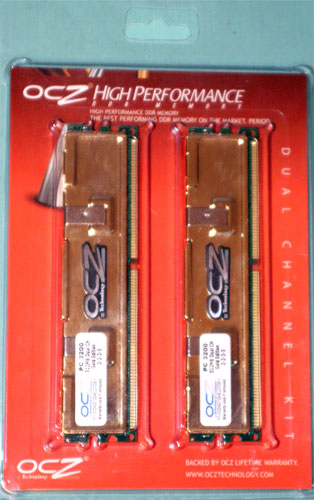

Specifications
OCZ PC3200 Gold is the only memory in the Value RAM roundup to be rated at 2-2-2-5 timings.| OCZ PC3200 Gold (DDR400) Memory Specifications | |
| Number of DIMMs & Banks | 2 DS |
| DIMM Size Total Memory |
512 MB 1GB |
| Rated Timings | 2-2-2-5 at DDR400 |
| SPD (Auto) Timings | 2-3-2-5 |
| Rated Voltage | 2.6V |
The SPD is set for "auto" timings to 2-3-2-5. To achieve full 2-2-2 timings, you need to adjust memory timings in BIOS. This is the first opportunity that we have had to test BH5 with high memory voltages. The DFI nForce4 SLI has adjustments to 4.0V in BIOS, so we were able to see for ourselves if the BH5 legends were really true.
Test Results
3.4V is hardly the kind of voltages available on most motherboards - particularly those boards that might use Value RAM. To get this kind of voltage, you need a production DFI nForce4 board - Ultra at about $133 or SLI for $184 to $215. You can also achieve these voltages on many motherboards with an OCZ DDR Booster at about $40. What you can do with voltage and BH5, however, is amazing.| OCZ PC3200 Gold (DDR400) - 2 x 512Mb Double-Bank | |||||||
| CPU Ratio at 2.4GHz | Memory Speed |
Memory Timings & Voltage |
Quake3 fps |
Sandra UNBuffered | Sandra Standard Buffered |
Super PI 2M places (time in sec) |
Wolfenstein - Radar - Enemy Territory fps |
| 12x200 | 400 DDR | 2-2-2-6 2.6V 1T |
568.9 | INT 2984 FLT 2960 |
INT 6100 FLT 6095 |
81 | 120.0 |
| 11x218 | 436 DDR | 2-2-2-6 2.8V 1T |
580.0 | INT 3053 FLT 3132 |
INT 6486 FLT 6413 |
81 | 122.3 |
| 10x240 | 480 DDR | 2-2-2-6 3.1V 1T |
596.7 | INT 3234 FLT 3241 |
INT 6731 FLT 6769 |
80 | 124.6 |
| 11x255 (2.8GHz) |
Highest CPU/Mem Performance 510 DDR |
2-2-2-7 3.4V 1T |
636.5 | INT 3359 FLT 3517 |
INT 7575 FLT 7493 |
69 | 133.5 |
The original BH5 was great up to about DDR450 at decent timings. Above that, it quickly gave out of range - or at least we thought it did in those days. It appears that BH5 with voltage allows 2-2-2 timings to be maintained to levels over DDR500. Frankly, for most users searching for Value RAM, this OCZ PC3200 Gold should be considered as very good and useful to about DDR450 to DDR460, at voltages of 2.9V and lower with very good 2-2-2 to 2.5-3-2 timings. Mad overclockers can consider this an incredible bargain. Feed this value BH5 the voltage and it will deliver at 2-2-2 timings. If you have one of the DFI nForce4 boards, this is one of the memories that can show off what high memory voltage can do.
We have found Aida benchmarks to be very useful in examining read/write performance and memory latency. Aida 32 is now available as Everest Home Edition, a free download from www.lavalys.com.
| OCZ PC3200 Gold (DDR400) 2x512Mb Double-Bank Everest 1.51 |
|||||
| CPU Ratio at 2.4GHz | Memory Speed | Memory Timings & Voltage |
Everest READ MB/s |
Everest WRITE MB/s |
Everest Latency ns |
| 12x200 | 400 DDR | 2-2-2-6 2.6V 1T |
5892 | 2027 | 45.8 |
| 11x218 | 436 DDR | 2-2-2-6 2.8V 1T |
6275 | 2135 | 43.4 |
| 10x240 | 480 DDR | 2-2-2-6 3.1V 1T |
6803 | 2323 | 39.5 |
| 11x255 (2.8GHz) |
Highest CPU/Mem Performance 510 DDR |
2-2-2-7 3.4V 1T |
7268 | 2460 | 37.0 |
Maintaining a constant CPU Speed of 2.4GHz and constant memory timings of 2-2-2, we measured the impact of increasing the Memory Speed from 200 to 240, a 20% increase. Both Memory Read and Memory Write performance increased by about 15%, while Latency improved by a similar 14%. This translated into improvement in game FPS from 4% to 5% at a constant CPU speed.
Transcend JM366D643A-50
Transcend will be best known to some of our readers as a manufacturer of flash memory. While flash memory is an important product line for Transcend, they also manufacture storage products and system memory. You will not find Transcend for sale at a huge number of US websites, but Transcend also sells directly to end-users at their website. Transcend has US sites in both Spanish and English, as well as several European language sites, and Taiwan, Japan and China websites.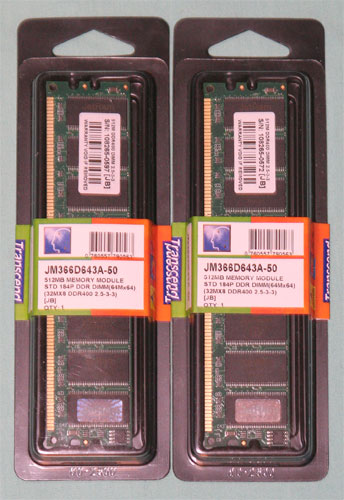
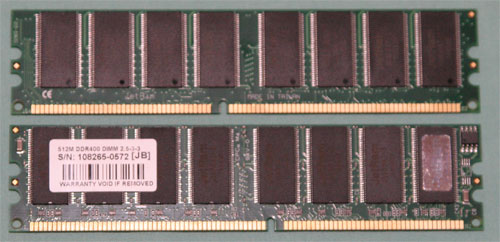
Specifications
Transcend rates JM366D643A-50 at DDR400 CAS 2.5 and we found the "auto" or SPD timings to be 2.5-3-3-8.| Transcend JM366D643A-50 (DDR400) Memory Specifications | |
| Number of DIMMs & Banks | 2 DS |
| DIMM Size Total Memory |
512 MB 1GB |
| Rated Timings | 2.5-3-3 |
| SPD (Auto) Timings | 2.5-3-3-8 |
| Rated Voltage | 2.6V |
Transcend shows both DDR400 CAS 2.5 and DDR400 CAS 3 in their product list, so it is clear that the DIMM products from Transcend are aimed at the Value end of the memory market.
Test Results
| Transcend JM366D643A-50 - 2 x 512Mb Double-Bank | |||||||
| CPU Ratio at 2.4GHz | Memory Speed |
Memory Timings & Voltage |
Quake3 fps |
Sandra UNBuffered | Sandra Standard Buffered |
Super PI 2M places (time in sec) |
Wolfenstein - Radar - Enemy Territory fps |
| 12x200 | 400 DDR | 2.5-3-3-6 2.6V 1T |
532.0 | INT 2420 FLT 2593 |
INT 6050 FLT 6036 |
82 | 111.9 |
| 11x218 | 436 DDR | 3-3-3-6 2.8V 1T |
529.2 | INT 2593 FLT 2735 |
INT 6393 FLT 6309 |
82 | 111.7 |
| 12x223 (2.68GHz) |
Highest CPU/Mem Performance | 3-3-3-7 2.8V 1T |
575.5 | INT 2668 FLT 2835 |
INT 6650 FLT 5516 |
75 | 122.5 |
Transcend is another memory that costs just $100 for a Gigabyte and yet manages to nearly reach DDR450 in overclocking. The cost and performance are very similar to the Kingston CAS 3 rated Value RAM except that Transcend rates its Value RAM at CAS 2.5. While the rated timings differ, both Kingston and Transcend both are stable at CAS 2.5 at DDR400. The Transcend RAM is an excellent value and provides the overclocking capabilities to reach a 12% CPU overclock at 1:1 memory ratio.
We have looked at Aida 32 results in the past, and found them to be very useful in examining read/write performance and memory latency. Aida 32 is now available as Everest Home Edition, a free download from www.lavalys.com.
| Transcend JM366D643A-50 (DDR400) 2x512Mb Double-Bank Everest 1.51 |
|||||
| CPU Ratio at 2.4GHz | Memory Speed | Memory Timings & Voltage |
Everest READ MB/s |
Everest WRITE MB/s |
Everest Latency ns |
| 12x200 | 400 DDR | 2.5-3-3-6 2.6V 1T |
5801 | 1861 | 47.7 |
| 11x218 | 436 DDR | 3-3-3-6 2.8V 1T |
6028 | 1906 | 48.8 |
| 12x223 (2.68GHz) |
Highest CPU/Mem Performance 446 DDR |
3-3-3-7 2.8V 1T |
6306 | 1989 | 47.9 |
It is easy to see in the Everest results that dropping CAS just from 2.5 to 3 in moving from DDR400 to DDR436 offsets virtually all of the performance improvements that you get from higher memory speed. The $100 Transcend reaches on to DDR446 to give you most of the headroom that you need for air-cooled 1:1 overclocking at stock multipliers.
Performance Comparisons
Performance of the seven Value memories was compared to all of the memory recently tested on the DFI nF4 AMD Athlon 64 platform. Results are also generally comparable to earlier results on the nForce3 testbed using the AGP version of the same nVidia 6800 video card. The performance differences will be that the nVidia 71.84 driver is a bit faster than the 61.77 used in earlier memory review.While we did not test on an Intel platform, the performance results can also be broadly compared to previous DDR benchmark results on the Intel 875 memory test bed. More results are available in recent DDR memory reviews at:
Patriot DDR400 2-2-2/DDR533 3-4-4: Performance AND Value
OCZ VX Revisited: DDR Updates on DFI nForce4
OCZ VX Memory + DFI nForce4 = DDR533 at 2-2-2
Corsair 4400C25: Taking Samsung TCCD to New Heights
PQI & G. Skill: New Choices in 2-2-2 Memory
Athlon 64 Memory: Rewriting the Rules
OCZ 3700 Gold Rev. 3: DDR500 Value for Athlon 64 & Intel 478
Geil PC3200 Ultra X: High Speed & Record Bandwidth
= F-A-S-T= DDR Memory: 2-2-2 Roars on the Scene
Buffalo FireStix: Red Hot Name for a New High-End Memory
New DDR Highs: Shikatronics, OCZ, and the Fastest Memory Yet
The Return of 2-2-2: Corsair 3200XL & Samsung PC4000
OCZ 3700EB: Making Hay with Athlon 64
OCZ 3500EB: The Importance of Balanced Memory Timings
Mushkin PC3200 2-2-2 Special: Last of a Legend
PMI DDR533: A New Name in High-Performance Memory
Samsung PC3700: DDR466 Memory for the Masses
Kingmax Hardcore Memory: Tiny BGA Reaches For Top Speed
New Memory Highs: Corsair and OCZ Introduce DDR550
OCZ PC3700 Gold Rev. 2: The Universal Soldier
OCZ 4200EL: Tops in Memory Performance
Mushkin PC4000 High Performance: DDR500 PLUS
Corsair TwinX1024-4000 PRO: Improving DDR500 Performance
Mushkin & Adata: 2 for the Fast-Timings Lane
Searching for the Memory Holy Grail – Part 2
Kingston KVR400X64C25/512, Kingston KVR400X64C3AK2/1G, Mushkin PC3200 EM, OCZ PC3200 Value Series (VX), OCZ PC3200 Gold (BH5), OCZ PC3200 Premier, and Transcend JM366D643A-50 were compared at 200x12 (2.4Ghz, DDR400), 218x11 (2.4Ghz, DDR438), 240x10 (2.4Ghz, DDR480), and the Highest Memory Performance Settings that we could reach. With a constant CPU speed, memory comparisons (except for top performance) show the true impact of faster speed and slower memory timings on memory performance.
DDR400/2.4GHz Performance
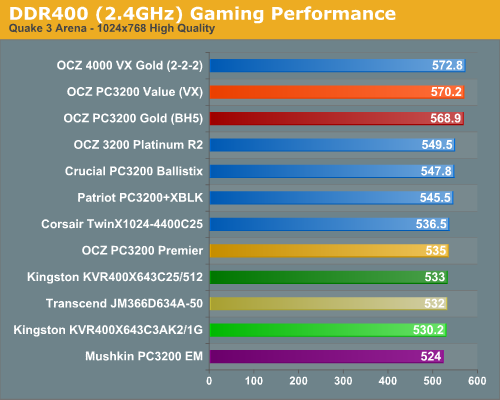
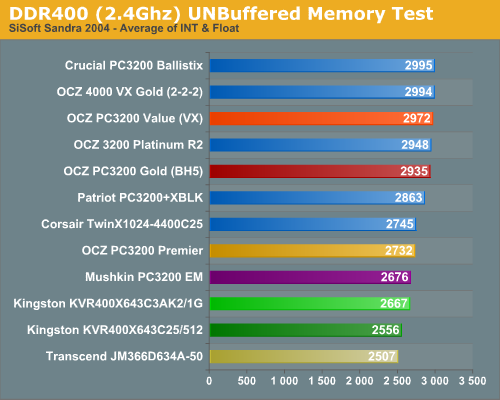
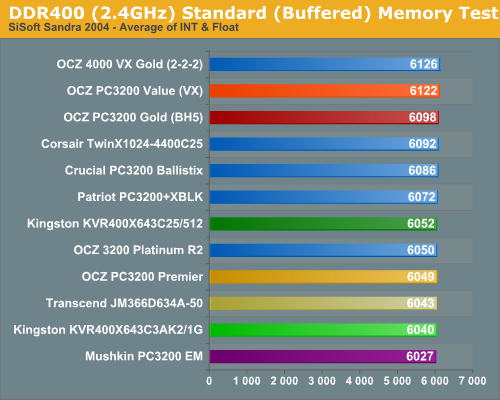
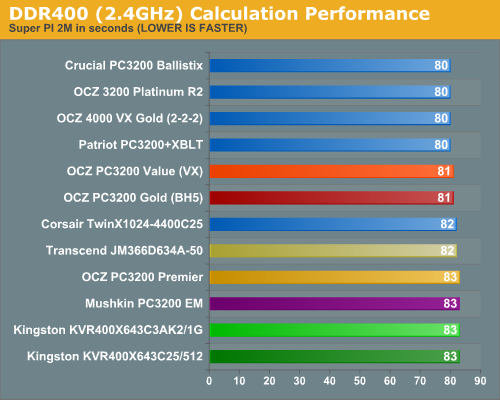
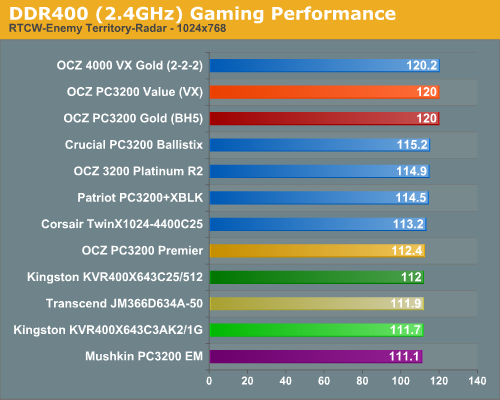
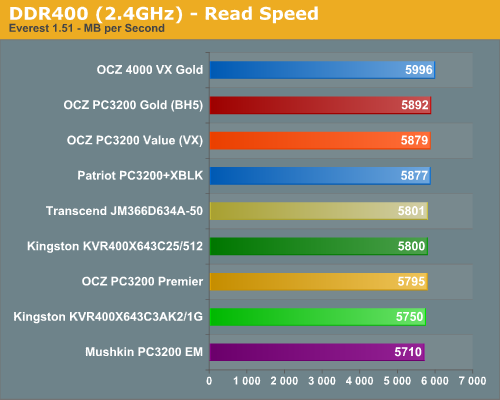
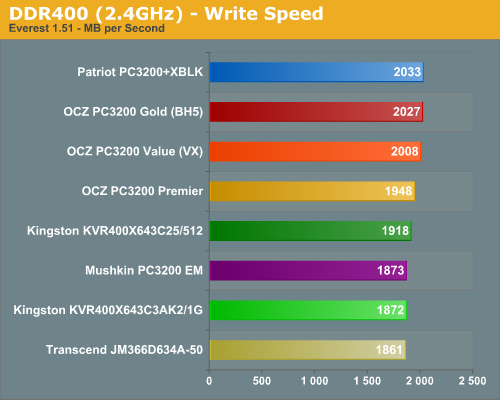

DDR436/2.4GHz Performance

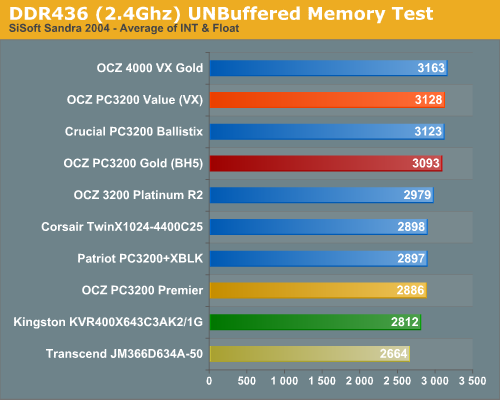
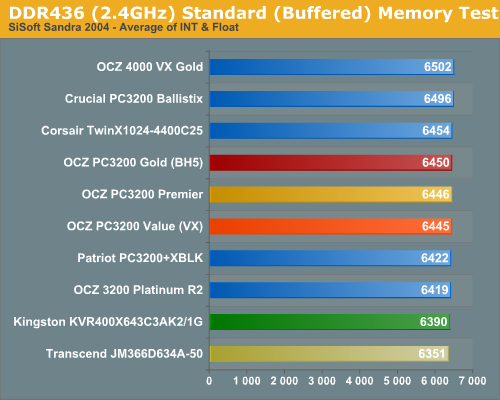
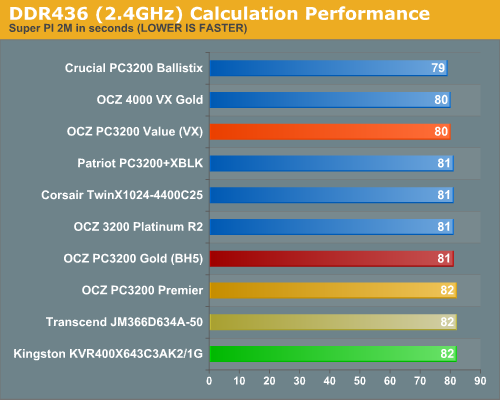


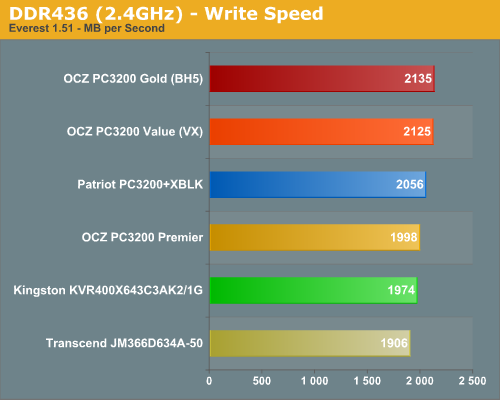
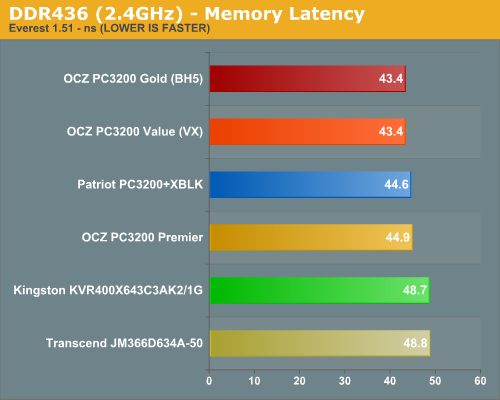
DDR480/2.4GHz Performance
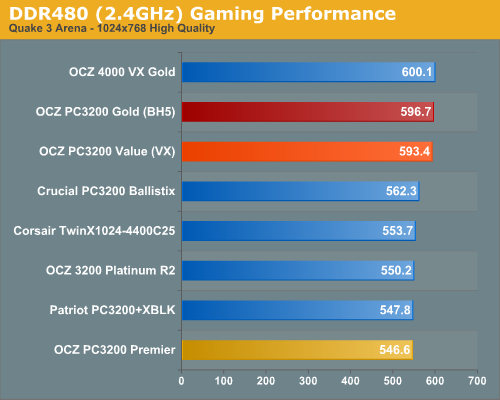
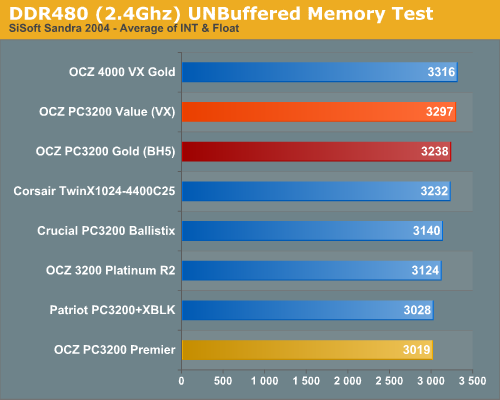
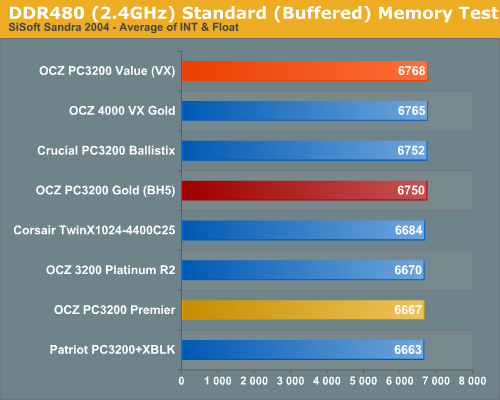

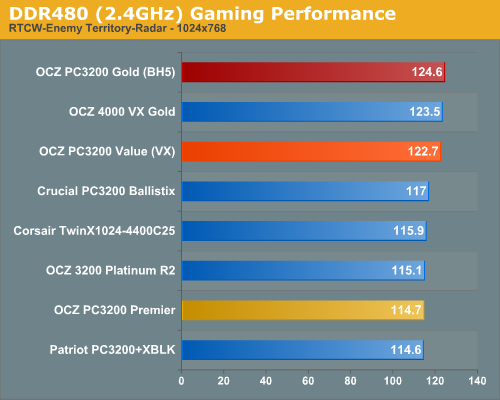

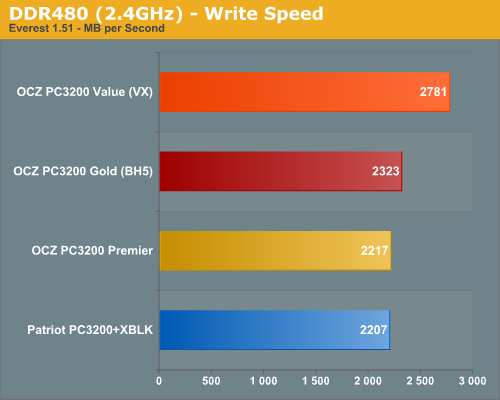
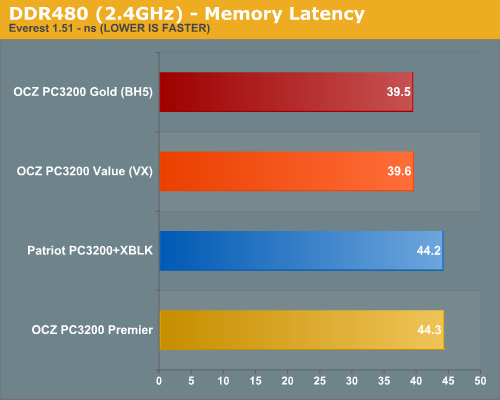
Highest Memory Performance

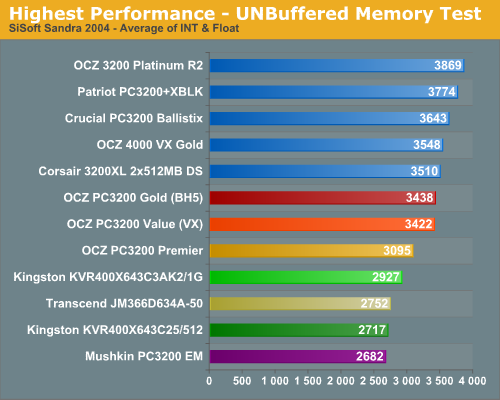
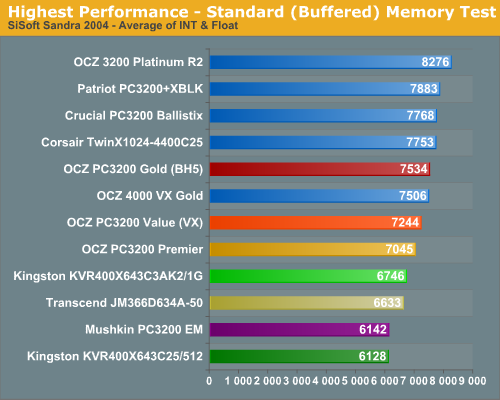
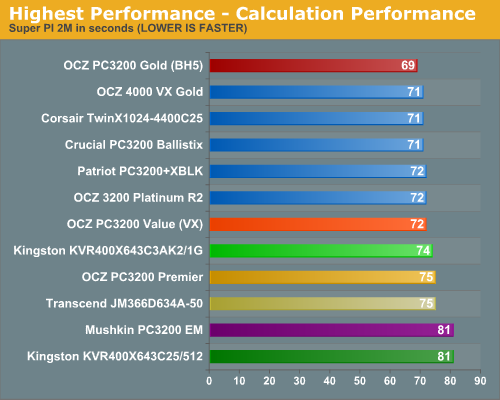

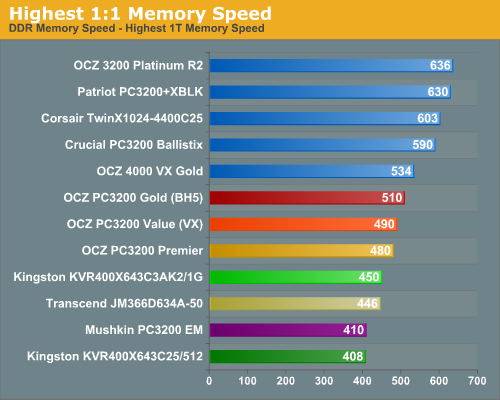

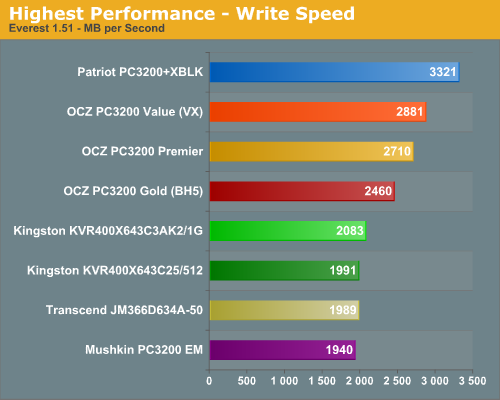
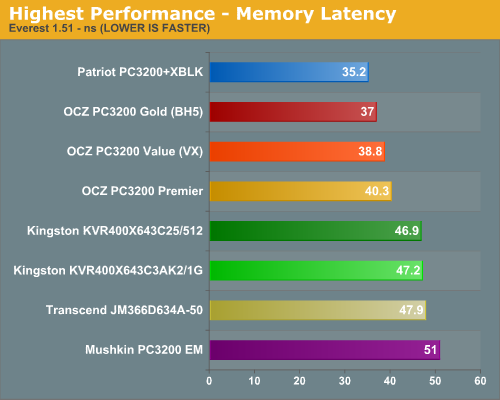
Final Words
"And the winner is..." really depends on how you plan to use your Value RAM. Some buyers ask nothing more than that their memory run at stock DDR400 speed as specified. If that buyer is you, then any of the seven memories that we tested here will meet your needs. All 7 of them ran at their specification or better without any problems at all. We would suggest that the CAS 2.5 memories are a bit faster and cost about the same as the Cas 3 we tested. Great choices here are the Kingston KVR400X64C3AK2/1G and the Transcend JM366D643A-50. 1 Gigabyte of either memory costs about $100 and they are sometimes on sale for even less. The Transcend is rated at CAS 2.5. The Kingston KVR400X64C3AK2/1G is rated at CAS 3, but we had no problem at all running the Kingston at CAS 2.5 at DDR400.The Kingston and Transcend stop at DDR450, and if your budget can stretch $21 to $121 for a Gigabyte of memory, the excellent OCZ PC3200 Premier will give you CAS 2.5 performance all the way up to around DDR480. This will cover the highest 1:1 overclock that you are likely to achieve with air cooling on any AMD Athlon 64 CPU. If your budget can stretch to around $195, you can buy famous Winbond BH5 again in OCZ PC3200 Gold. This will give you the absolute fastest 2-2-2 timings at DDR400 at default voltage - and a whole lot more if you want to overclock now or in the future. 2-2-2 timings are definitely faster, but we would choose a faster CPU over the faster RAM, if that is what the $95 represents in your budget, and you don't plan to overclock.
If you have any overclocking plans at all, exclude the other Kingston memory, Kingston KVR400X64C25/512, and Mushkin EM. They both had trouble even reaching a CPU clock of 205 on our test platform. There are much better choices for overclocking in this roundup. This may be a compatibility issue of these memory chips with the AMD on-chip memory controller or the DFI motherboard, but whatever the reason, they don't clock even modestly on our test bed. There are other choices available from both Kingston and Mushkin, and almost any choice will likely do better at overclocking than these two.
Last, we get to the Mad Overclockers category, or maybe the mad overclocker wannabes. There is an old southern saying that you can't make a sow's ear into a silk purse - another way to say, you can't get something for nothing. Two memories in this roundup challenge that old sage - OCZ PC3200 Gold or "Value BH5" and OCZ PC3200 Value Series or "Value VX". If you can supply the voltage, then these two memories will reward you with 2-2-2 performance all the way from DDR490 to DDR510. Considering that the king of 2-2-2, OCZ PC4000 VX, sells for about $270, these 2 memories are true bargains at $115 for Value VX or $195 for Value BH5. They will neither likely reach quite as far as 4000 VX, but they will come close. VX itself is still a great value at $270 when you compare its performance to other memories in the $250 to $400 price range.
You will need memory voltage up to 3.5 volts or so to reach these performance levels with VX or BH5, but the memory itself is cheap "sow's ear" pricing. Some overclockers get their greatest thrills out of pushing cheap parts to unheard of performance levels. That is why the Intel P4 2.4GHz Northwood became legend. These two memories fit that category. You will need an OCZ DDR Booster to supply the voltages on some motherboards, a voltage mod on others, or a new DFI nForce4 if you want up to 4.0V out of the box. But if you supply the voltage, these two memories will provide legendary performance.
The winner depends on your needs. Frankly, the Value VX deserves a Gold Award from someone simply for the incredible performance at chicken feed prices. The BH5 revival is similarly worthy. The OCZ Premier reaches DDR480 at CAS 2.5 and costs just $121, and the pair of $100 CAS 2.5's are a stellar value. There are quite a few winners in this roundup - the winner for you depends on how you plan to use your Value RAM. We hope that we provided enough information on each of these memories to make your choice for best Value RAM an easier decision.







